The Golden Hawk was the first in a line of several “Hawk” branded automobiles that Studebaker-Packard produced between 1956 and 1964. The 1956 edition would be the most unique as it was the only year that a Packard V8 was under the hood (replaced by supercharged Studebaker motors in 1957). This ’56 is one of just 4,073 copies built and it needs a ton of work, having been stored for more than 40 years. It comes with a bunch of spares from two other Studebakers the seller has and can be found in Watertown, South Dakota. This project is available here on eBay where the bidding is just $810 but the seller has set a reserve. Plus, there’s a Buy It Now option for $4,500. Thanks for this rare vintage tip, T.J.!
Taking its shape from the 1953–55 Champion/Commander/Starliner hardtop coupes, the Golden Hawk was in production for three years. It had several companions over the years, including the Gran Turismo Hawk, which was the most luxurious of the cars and the last when Studebaker quit building automobiles in the U.S. in 1964. The Golden Hawk had a raised hood and Mercedes-like grill to accommodate the 352 cubic inch V8 that came from Packard. The engine provided a great power-to-weight ratio and the ’56 Golden Hawk was only surpassed for speed by the more expensive Chrysler C-Series cars. The Golden Hawk lost its Packard power in 1957 when the company sold off its engine building plant.
The seller provides a ton of details about what he/she has done to this automobile while owning it. The goal was to turn it into a restomod, but Studebaker purists gave him a lecture about that so he hopes someone else will restore it to its original-like condition. Apparently what took the car out of commission initially was that the hood flew open, breaking the windshield and damaging some of the trim. So, it’s spent at least four decades in one building or another going through some adjustments along the way.
Much of the sheet metal either has rust or has been damaged due to one calamity or another. The hood was finally replaced after the “blow-up” incident. Some suspension work has been done and not everything is hooked up, but most of the parts are there. Inside the car, the front seat is missing but the rear is intact, and the door panels will need work. The seller has both a 1956 Power Hawk and a 1953 Starliner that parts can be taken from if the buyer is willing to do the work.
The 352 V8 and overdrive transmission are numbers matching and the seller has the car’s original production order. The engine was disassembled years ago and is loosely put back together but will need to be rebuilt. Some of its parts will have to be sourced in the process as the camshaft, pistons, and other things have flown the coop. The Studebaker may still wear its original Romany Red and Snowcap White paint which would make a beautiful combination when this auto is restored. Could you be the one to put Humpty Dumpty back together again?



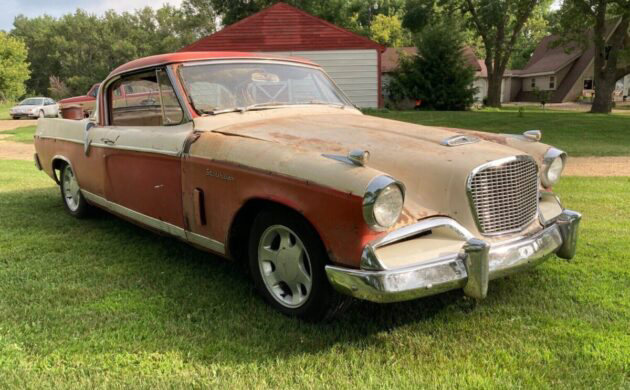


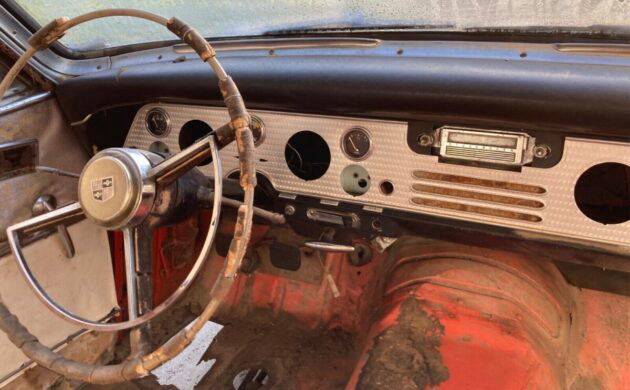
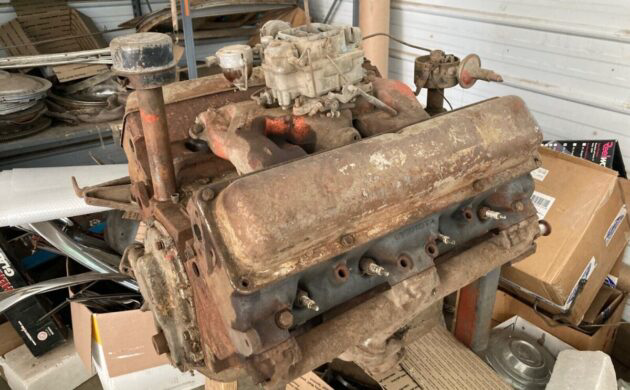
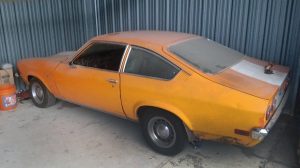
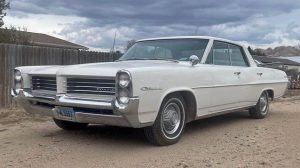
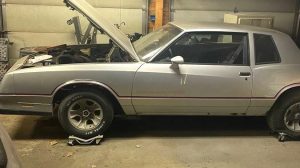
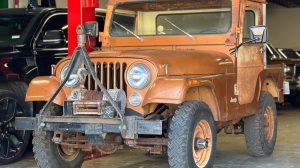


Squint and the 1st photo presents an attractive look, just don’t look under the hood or open the doors to peer inside.
Oh, my aching wallet.
Maybe it would be smart to look at the other two cars, if the seller would part with one, and leave this one where it is. Nothing there worth the effort.
Actually, Studebaker shut down Packard’s engine plant after purchasing the brand, and used up the remaining Packard engines in ’56. After that, there weren’t no mo’.
Packard actually bought Studebaker and came to regret not getting a closer look at the books beforehand. If they had done so the buyout probably never would have happened.
Wrong…….you get an F in history.
Stillrunners,
Actually, Rick is correct. While it was generally seen as an “equal merger” for the publicity, it WAS Packard that purchased Studebaker. And yes, the numbers crunchers at South Bend had indeed kept 2 sets of ledgers. and Packard was in such a hurry to close the deal they didn’t have an independent audit done before the purchase. It was financially impossible for Studebaker to purchase Packard because the company was close to financial ruin.
What they quickly discovered that while Studebaker was manufacturing a very large number of vehicles compared to Packard, and Packard was making money, Studebaker was losing money on every vehicle sold.
The big book on the Packard Motor Car Company by Beverly Rae Kimes has an excellent chapter on exactly what happened with the merger.
Packard? Looks like a Studebaker to me.
Yes, with a Packard V8 under the hood, hence the headline.
How fast would you have to go for that half a car hood to blow up – yikes! that would scare the beans out of ya.
Not that fast at all. We installed safety chains on ours. The hood lack was not very good and would unlatched. If it weren’t for the chain I would had the same problem. I was doing 55.
Too bad he could not find a 56 hood. They were one year only. This will be a labor of love if someone does take it on.
If I was to tackle this project, when it comes to the engine I would make some internal changes. Since it needs internal parts I would source a senior Packard 374 engine for parts, and rebuild it with the 374 crank. Years ago I had the opportunity to drive a Golden Hawk with the 374 conversion, and it was quite the hot car!
The rear axle also needs to be replaced with one that has the Twin Traction diff, Those hawks with the TT diff had a TT emblem on the gas door, and this one doesn’t show it ever had the emblem.
THIS IS A VERY RARE CAR IF IT IS A FACTORY MANUAL TRANSMISSION GOLDEN HAWK. Factory records indicate only 2 1956 Golden Hawks were built with power steering, power brakes, and the OD T-85 trans. There are no photos of the engine compartment so I can’t see if it has PS and PB, but if so, it’s VERY RARE.
Prior to buying this I would make sure it is a real Golden Hawk based on the VIN and body tag on the firewall, and not a lesser Hawk that someone pulled the 289 out, and intended to refit a Packard motor to it. My own feeling is this is a genuine GH, but it’s best to be sure, as GH parts can be installed on any hardtop body shell.
As I prefer stick shift, I would make sure the manual transmission bell housing for the ’55-’56 Packard V8 is there, that big cast iron part is very hard to find. The rest of the stick shift parts are regular Studebaker. I would change the gearbox to the later Ford 3-speed & OD trans, it’s the same B-W T-85 as the Studebaker gearbox, except the Ford trans has 1st gear syncro.
While the body is quite rusty, there is a nice selection of repro body panels available. NOS front fenders have been unavailable for the last 50 years, but the doors and all 4 fenders can be sourced as rust-free panels. Much of the special Golden Hawk trim and interior items are available either as NOS or repro.
My own personal change from stock would be to install a dual master cylinder under the floor to replace the single master cylinder, and I would source the original 1963-64 Studebaker Dunlop disc brakes.
IMPORTANT NOTE FOR ALL HAWK OWNERS 1956 TO 1964:
The Hawk hood assembly can shift from side to side due to it’s flexible design, especially if the rubber “buttons” along the inner top edges of the front fenders are missing or worn down. The hood rests on those buttons. If the hood shifts enough it can slip out of the hood latch and at speed it WILL fly up and fold over the windshield onto the roof.
There are pairs of sheet metal braces that can be welded to the sides of the hoods next to the hood hinge attachment points. These help keep the hood from flexing. But I also suggest that every Hawk owner install a leather belt around the front bumper, under the center of the front body and into the area just behind the hood latch. Pass the belt end thru the Hawk’s center grill ribs. Always make sure the belt is buckled before driving. When your hood does unlatch [and it probably will], you will be glad you had the belt in place.
Dang….now you tell me….a collectors assorted Stude Hawks ended up in a yard I go to – one was a stripped pretty good 1956 GH with that standard trans still behind the Packard motor. The car stayed for a while and when I went one day it was gone…..
Wow yourself know your Studebakers!
I love the look of the Hawk series. Studebaker’s tended to rust up here in Ontario, but there is no denying they sure were good looking cars.
Bill it is a GH it is registered in the 56j group
Since it needs internal parts I would source a senior Packard 374 engine for parts, and rebuild it with the 374 crank.”
Yes, a 374″ makes for a stronger ’56J.
No, the 352″ and the 374″ crankshaft are both the same 3.500″ stroke. It’s the 4.125″ bore which produces the additional twent-two cubic inches.
Given that 374″ pistons are NLA, dig a bit deeper for custom 4.1875″ forged pistons to build a 394″.
jack vines
Wow another deep pockets car. Don’t like the hood problems, I’d want to probably install hood pins like they use in stock car races. That would guarantee the hood won’t fly up in your face. A heck of a lot better than a belt.
George,
Because of the shape of the hood and the need to pull the hood forward when lifting it up, hood pins really aren’t a good choice, hence people use belts, short lengths of chains, even bungi cords. I used the belt because it can be removed and installed over & over again, without having to attach it to the car. And the soft leather doesn’t harm finishes.
Just went out to the garage and looked over my ’62 GT Hawk. All the bumpers have been replaced and the latch is working as it should. When closed, the hood can’t be moved at all in any direction. The safety catches it as it should if the first latch doesn’t. I tried moving the hood forward, it wouldn’t let go. Not sure how the hood would fly up if the latch and bumpers are as they were from the factory.
Fred W,
You are indeed a lucky Hawk owner! The number 1 reason all Hawk hoods are hard to find in an undamaged condition, is this tendency to fly up at high speeds due to latch failure.
Keep in mind that the Hawk hood is very long and has zero side supporting members. It’s strength depends on the small side panels created in the stamping process, and that is simply not enough strength when the hood is subject to extreme flexing. The only additional “welded in” hood support pieces are at the very front and rear. That flexing also happens in the car’s frame. Studebaker frames are more flexible than other 1950s American “body-on-frame” cars.
It’s been my experience from operating a shop specializing in Studebakers, that in unexpected high-speed extreme situations like hitting a deep pothole, crossing railroad tracks, or running over a road obstacle, these problems can flex the front clip & frame rails to the point the hood does pop up.
I started buying GT hawks when they were simply older used cars, and even then Hawk hoods were getting hard to find, and the vast majority showed evidence of flexing to the point the edges of the hoods right in front of the hinge mounting bolts had metal fatigue cracks on the underside. If those cracks are not repaired, the hood will continue to flex up & down at those side points.
While it’s important to make sure the hood sits properly and doesn’t move along the fender lines, it’s important to keep in mind the hoods fly up at speeds typically above about 40 mph, when you least expect it to happen.
A thrift store sourced $1 used child’s size belt, buckled in place, is a cheap insurance policy compared to the cost of a good “never flown” Hawk hood that costs at least $1,500 and still needs hinge mounting supports welded in place, and the hood painted to match the car.
And remember, there are specific ways to open and shut Hawk hoods. On opening, once the hood has cleared the secondary latch point, the hood needs to be pulled forward as you lift up in a gentle curve. On closing, it’s the reverse, keeping the hood pulled forward as it’s lowered. Once the hood is sitting on the latch, that’s the point where you can push down on the hood at the top where the grill shell is located. Never let the hood drop into place, even a few inches.